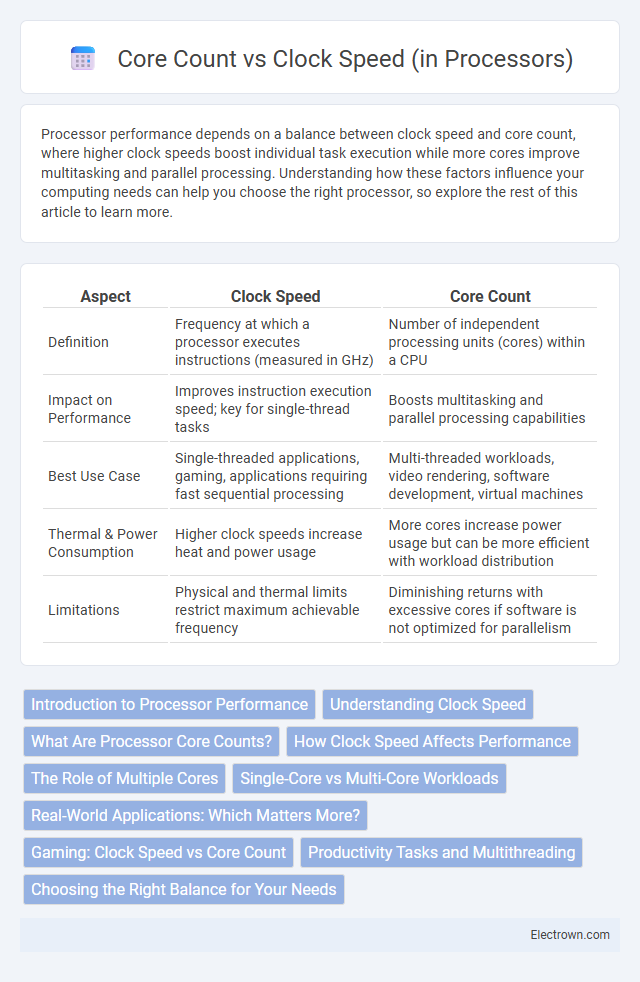Processor performance depends on a balance between clock speed and core count, where higher clock speeds boost individual task execution while more cores improve multitasking and parallel processing. Understanding how these factors influence your computing needs can help you choose the right processor, so explore the rest of this article to learn more.
Table of Comparison
| Aspect | Clock Speed | Core Count |
|---|---|---|
| Definition | Frequency at which a processor executes instructions (measured in GHz) | Number of independent processing units (cores) within a CPU |
| Impact on Performance | Improves instruction execution speed; key for single-thread tasks | Boosts multitasking and parallel processing capabilities |
| Best Use Case | Single-threaded applications, gaming, applications requiring fast sequential processing | Multi-threaded workloads, video rendering, software development, virtual machines |
| Thermal & Power Consumption | Higher clock speeds increase heat and power usage | More cores increase power usage but can be more efficient with workload distribution |
| Limitations | Physical and thermal limits restrict maximum achievable frequency | Diminishing returns with excessive cores if software is not optimized for parallelism |
Introduction to Processor Performance
Processor performance relies heavily on the balance between clock speed and core count, where clock speed measures how many cycles a processor can execute per second, directly impacting task execution speed. Core count enables parallel processing, allowing multiple tasks to run simultaneously, which is crucial for multitasking and demanding applications. Understanding how your processor's clock speed and core count work together helps optimize computing efficiency and enhances your overall system responsiveness.
Understanding Clock Speed
Clock speed, measured in gigahertz (GHz), determines how many cycles a processor can execute per second, directly influencing its performance in single-threaded tasks. Higher clock speeds enable faster processing of instructions, enhancing your device's responsiveness during activities like gaming or web browsing. However, understanding clock speed alongside core count is crucial, as multiple cores handle multitasking and parallel processing more efficiently.
What Are Processor Core Counts?
Processor core counts refer to the number of independent central processing units (cores) within a single processor, each capable of executing tasks simultaneously, thus enhancing multitasking and parallel processing efficiency. Higher core counts can significantly improve performance in applications designed for multi-threading, such as video editing, 3D rendering, and complex simulations. Understanding your processor's core count helps you determine its suitability for your computing needs, balancing speed and workload distribution.
How Clock Speed Affects Performance
Clock speed directly influences how many cycles a processor can execute per second, measured in gigahertz (GHz), significantly impacting the speed of single-threaded tasks. Higher clock speeds allow Your CPU to process instructions faster, improving responsiveness in applications that rely heavily on sequential performance. However, real-world performance also depends on factors like core count and workload type, where some tasks benefit more from multiple cores than raw clock speed.
The Role of Multiple Cores
Multiple cores in processors significantly enhance multitasking capabilities and overall performance by allowing simultaneous execution of multiple tasks. While clock speed determines how fast each core operates, the presence of multiple cores enables your system to handle complex applications and parallel processes more efficiently. Leveraging the right balance between clock speed and core count is essential for optimizing processing power in modern computing environments.
Single-Core vs Multi-Core Workloads
Single-core workloads rely heavily on clock speed, as higher GHz enable faster task execution and better responsiveness in applications like gaming or basic software. Multi-core workloads benefit from increased core count, allowing parallel processing of threads in tasks such as video editing, 3D rendering, and multitasking, improving overall efficiency. Your choice depends on whether your applications prioritize raw speed per core or the ability to handle multiple processes simultaneously.
Real-World Applications: Which Matters More?
In real-world applications, core count often outweighs clock speed for multitasking and parallel processing tasks such as video editing, 3D rendering, and data analysis, where multiple cores can handle simultaneous threads efficiently. Single-threaded tasks and gaming typically benefit more from higher clock speeds, as they rely on faster execution of individual instructions. Optimal processor performance depends on the specific workload, with workloads like AI development and scientific simulations favoring high core counts, while office productivity and older software benefit from higher clock speeds.
Gaming: Clock Speed vs Core Count
Higher clock speeds significantly improve gaming performance by enabling faster processing of game logic and frame rendering, which directly enhances frame rates and responsiveness. While core count contributes to multitasking and background processes, most modern games primarily benefit from faster cores rather than a higher number of cores, as many titles are optimized for 4 to 8 cores. Balancing a CPU with high clock speeds and a moderate core count, such as a 6-core or 8-core processor with clock speeds above 4.0 GHz, delivers optimal gaming performance.
Productivity Tasks and Multithreading
Higher clock speeds improve single-threaded performance that benefits productivity tasks like spreadsheet calculations and word processing by reducing latency and increasing responsiveness. Multiple cores enable better multithreading, efficiently handling parallel workloads such as video rendering, 3D modeling, and multitasking with multiple applications open. Balancing clock speed and core count is crucial, as productivity software can leverage higher clock speeds for faster execution, while multithreaded applications gain significant performance boosts from increased core counts.
Choosing the Right Balance for Your Needs
Selecting the right balance between clock speed and core count depends largely on your specific computing tasks. High clock speeds enhance single-threaded performance, ideal for gaming and applications requiring fast serial processing, while a greater core count benefits multitasking and parallel workloads like video editing or 3D rendering. Understanding your primary use cases ensures you optimize your processor choice for both efficiency and performance.
Clock Speed vs Core Count (in Processors) Infographic

 electrown.com
electrown.com